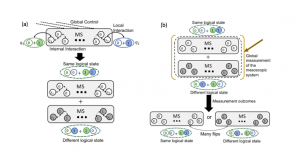Summary
Mesoscopic systems provide a new tool for quantum systems design. In particular, they are enabling of robust quantum control. Here “mesoscopic system” refers to a connected network where each element, if studied alone, would be a quantum bit. The network is too big to be treated fully quantum mechanically. We do not have individual control over each element and we measure collective properties of the network. However, the network retains quantum coherence and behaves in a uniquely quantum fashion. In this project, we design a novel protocol using an intermediate mesoscopic system to control and interconnect non-interacting qubits. Our method aims to create entanglement between two separated qubits; a pure quantum correlation between the target qubits that provides a measure of the mesoscopic system’s quantum capacity. Over the course of this project, we will develop new theory and experimental tools. Ultimately, we expect our work will lead to innovative design elements for use in quantum processor architectures and quantum measurement devices.

Figure 1: The summary of the entangling protocol: (a) The experimentally available control tools are used to correlate two joint logical states of the target with two very distinct collective states of the mesoscopic system, (b) A low-resolution global measurement over the mesoscopic system discerns between the distinct collective states of the mesoscopic system. This measurement updates the state of the qubits into one of the two logical joint states, each with a probability of ½, along with the state of the mesoscopic system. Both of these joint logical states are maximally entangled quantum states between the target qubits.
Related Content
QuantumIon: an open-access quantum computing platform
Summary Trapped ions are one of the most advanced technologies for quantum computing, offering multi-qubit control in a universal quantum computing architecture and the ability to perform calculations with unprecedented precision. In this project we construct a shared trapped-ion quantum computing platform, QuantumIon, that will enable a broader and interdisciplinary scientific community to access an […]
September 9, 2019

Metasurfaces for high-efficiency parametric downconversion and complex quantum state generation
Summary Entangled photon sources are crucial for quantum computing, quantum sensing, and quantum communication. Of growing importance are sources relying on spontaneous parametric downconversion (SPDC). Unfortunately, these sources of entangled photons are often constrained by momentum conservation laws. To overcome this limitation and expand the possibility of quantum state engineering, we intend to use metasurfaces […]
February 1, 2023

Combined momentum- and real-space photoelectric probes of dimensionality-tuned Weyl semimetals
Summary The library of two-dimensional (2D) materials has recently grown to include topological insulators and semimetals. Their incorporation in special device geometries may lead to novel quantum electronics with enhanced functionalities. Weyl semimetals, in particular, offer the most robust form of topological protection. Recent results from our group indicate that Weyl nodes should be […]
March 12, 2019


